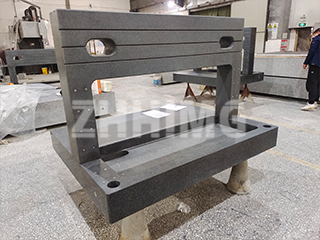The granite surface plate is a precision reference tool made from natural stone materials. It is widely used for the inspection of instruments, precision tools, and mechanical parts, serving as an ideal reference surface in high-accuracy measurement applications. Compared with traditional cast iron plates, granite surface plates offer superior performance due to their unique physical properties.
Technical Support Required for Manufacturing Granite Surface Plates
-
Material Selection
Granite surface plates are made from high-quality natural granite (such as gabbro or diabase) with fine crystalline texture, dense structure, and excellent stability. Key requirements include:-
Mica content < 5%
-
Elastic modulus > 0.6 × 10⁻⁴ kg/cm²
-
Water absorption < 0.25%
-
Hardness > 70 HS
-
-
Processing Technology
-
Machine cutting and grinding followed by manual lapping under constant temperature conditions to achieve ultra-high flatness.
-
Uniform surface color without cracks, pores, inclusions, or loose structures.
-
No scratches, burns, or defects that could affect measurement accuracy.
-
-
Accuracy Standards
-
Surface roughness (Ra): 0.32–0.63 μm for the working surface.
-
Side surface roughness: ≤ 10 μm.
-
Perpendicularity tolerance of side faces: conforms to GB/T1184 (Grade 12).
-
Flatness precision: available in grades 000, 00, 0, and 1 according to international standards.
-
-
Structural Considerations
-
Central load-bearing area designed to withstand rated loads without exceeding allowable deflection values.
-
For 000-grade and 00-grade plates, no lifting handles are recommended to maintain accuracy.
-
Threaded holes or T-slots (if required on 0-grade or 1-grade plates) must not extend above the working surface.
-
Usage Requirements of Granite Surface Plates
-
Surface Integrity
-
The working surface must remain free from serious defects such as pores, cracks, inclusions, scratches, or rust marks.
-
Small edge chipping or minor corner defects are allowed on non-working areas, but not on the measuring surface.
-
-
Durability
Granite plates have high hardness and wear resistance. Even under heavy impact, only small chips may occur without affecting overall precision—making them superior to cast iron or steel reference parts. -
Maintenance Guidelines
-
Avoid placing heavy parts on the plate for long periods to prevent deformation.
-
Keep the working surface clean and free of dust or oil.
-
Store and use the plate in a dry, temperature-stable environment, away from corrosive conditions.
-
In summary, the granite surface plate combines high strength, dimensional stability, and exceptional wear resistance, making it indispensable in precision measurement, machining workshops, and laboratories. With proper technical support in manufacturing and correct usage practices, granite plates can maintain accuracy and durability over long-term applications.
Post time: Aug-19-2025

